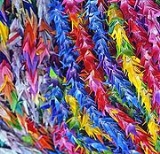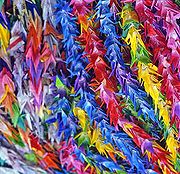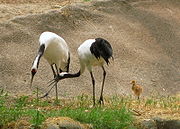
Thousand origami cranes
Encyclopedia

Origami
is the traditional Japanese art of paper folding, which started in the 17th century AD at the latest and was popularized outside Japan in the mid-1900s. It has since then evolved into a modern art form...
paper cranes
Crane (bird)
Cranes are a family, Gruidae, of large, long-legged and long-necked birds in the order Gruiformes. There are fifteen species of crane in four genera. Unlike the similar-looking but unrelated herons, cranes fly with necks outstretched, not pulled back...
(鶴 tsuru) held together by strings.
An ancient Japanese legend promises that anyone who folds a thousand origami cranes will be granted a wish by a crane, such as long life or recovery from illness or injury. The crane in Japan is one of the mystical or holy creatures (others include the dragon and the tortoise), and is said to live for a thousand years. In Japan, it is commonly said that folding 1000 paper origami cranes makes a person's wish come true. (expansion needed) This makes them popular gifts for special friends and family.
Cultural significance


Sets of origami paper
Paper
Paper is a thin material mainly used for writing upon, printing upon, drawing or for packaging. It is produced by pressing together moist fibers, typically cellulose pulp derived from wood, rags or grasses, and drying them into flexible sheets....
are sold widely in Japan, with Senbazuru sets including 1000 (or more, in case of mistakes) sheets of paper, string, and beads to place at the end of each string to stop the cranes from slipping off. Commonly the cranes are assembled as 25 strings of 40 cranes each.
The size of the origami paper does not matter when assembling a thousand paper cranes, but smaller sheets consequently yield smaller and lighter strings of cranes. The most popular size for Senbazuru cranes is 75 by 75 mm (3 by 3 ). Some people cut their own squares of paper from anything available, such as magazines.
Origami paper
Origami paper
Origami paper is used to fold origami, the art of paper folding.-Kami:This paper is the easiest to find and cheapest to buy. It is also the most basic: kami, or koi paper. Kami is a thin, easy to fold paper. It is usually printed only on one side, with a solid color or pattern...
used for Senbazuru is usually of a solid color, though printed designs are also available. Larger size origami paper, usually 6x6 inches, often has traditional Japanese or flower designs, reminiscent of kimono
Kimono
The is a Japanese traditional garment worn by men, women and children. The word "kimono", which literally means a "thing to wear" , has come to denote these full-length robes...
patterns.
The Thousand Origami Cranes has become a symbol of world peace
World peace
World Peace is an ideal of freedom, peace, and happiness among and within all nations and/or people. World peace is an idea of planetary non-violence by which nations willingly cooperate, either voluntarily or by virtue of a system of governance that prevents warfare. The term is sometimes used to...
through the story of Sadako Sasaki
Sadako Sasaki
was a Japanese girl who was two years old when the atomic bomb was dropped on August 6, 1945, near her home by Misasa Bridge in Hiroshima, Japan. Sadako is remembered through the story of attempting to fold a thousand origami cranes before her death, a wish which was memorialized in popular...
, a Japanese girl who tried to stave off her death from leukemia
Leukemia
Leukemia or leukaemia is a type of cancer of the blood or bone marrow characterized by an abnormal increase of immature white blood cells called "blasts". Leukemia is a broad term covering a spectrum of diseases...
as a result of radiation from the atomic bombing
Atomic bombings of Hiroshima and Nagasaki
During the final stages of World War II in 1945, the United States conducted two atomic bombings against the cities of Hiroshima and Nagasaki in Japan, the first on August 6, 1945, and the second on August 9, 1945. These two events are the only use of nuclear weapons in war to date.For six months...
of Hiroshima
Hiroshima
is the capital of Hiroshima Prefecture, and the largest city in the Chūgoku region of western Honshu, the largest island of Japan. It became best known as the first city in history to be destroyed by a nuclear weapon when the United States Army Air Forces dropped an atomic bomb on it at 8:15 A.M...
during World War II
World War II
World War II, or the Second World War , was a global conflict lasting from 1939 to 1945, involving most of the world's nations—including all of the great powers—eventually forming two opposing military alliances: the Allies and the Axis...
by making one thousand origami cranes, having folded only 644 before her death, and that her friends completed and buried them all with her. (This is only one version of the story. Hiroshima Peace Memorial Museum
Hiroshima Peace Memorial Museum
Hiroshima Peace Memorial Museum is located in Hiroshima Peace Memorial Park, in central Hiroshima, Japan.It was established in August 1955 with the Hiroshima Peace Memorial Hall ....
states that she did, in fact, complete the 1,000 cranes.)
Her story is told in the book Sadako and the Thousand Paper Cranes
Sadako and the Thousand Paper Cranes
Sadako and the Thousand Paper Cranes is a non-fiction children's book written by American author Eleanor Coerr and published in 1977.This true story is of a girl, Sadako Sasaki, who lived in Hiroshima at the time of the atomic bombing by the United States...
. Several temples, including some in Tokyo
Tokyo
, ; officially , is one of the 47 prefectures of Japan. Tokyo is the capital of Japan, the center of the Greater Tokyo Area, and the largest metropolitan area of Japan. It is the seat of the Japanese government and the Imperial Palace, and the home of the Japanese Imperial Family...
and Hiroshima
Hiroshima
is the capital of Hiroshima Prefecture, and the largest city in the Chūgoku region of western Honshu, the largest island of Japan. It became best known as the first city in history to be destroyed by a nuclear weapon when the United States Army Air Forces dropped an atomic bomb on it at 8:15 A.M...
, have eternal flames for World Peace. At these temples, school groups or individuals often donate Senbazuru to add to the prayer for peace. The cranes are left exposed to the elements, slowly dissolving and becoming tattered as the wish is released. In this way they are related to the prayer flags of India
India
India , officially the Republic of India , is a country in South Asia. It is the seventh-largest country by geographical area, the second-most populous country with over 1.2 billion people, and the most populous democracy in the world...
and Tibet
Tibet
Tibet is a plateau region in Asia, north-east of the Himalayas. It is the traditional homeland of the Tibetan people as well as some other ethnic groups such as Monpas, Qiang, and Lhobas, and is now also inhabited by considerable numbers of Han and Hui people...
.
In Western countries, the custom has been extended from giving a senbazuru to cancer patients, to using them at funerals or on the grave.
Renzuru
The term renzuru refers to an origami technique whereby one folds multiple cranes from a single sheet of paper (usually square), employing a number of strategic cuts to form a mosaic of semi-detached smaller squares from the original large square paper. (Unlike Western origami purists, traditional Japanese origami often uses paper cuts to add detail such as ears.) The resulting cranes are attached to one another (e.g., at the tips of the beaks, wings, or tails) or at the tip of the body (e.g., a baby crane sitting on its mother's back). The trick is to fold all the cranes without breaking the small paper bridges that attach them to one another or, in some cases, to effectively conceal extra paper.Typical renzuru configurations include a circle of four or more cranes attached at the wing tips. One of the simplest forms, made from a half square (2x1 rectangle) cut halfway through from one of the long sides, results in two cranes that share an entire wing, positioned vertically between their bodies; heads and tails may face in the same or opposite directions. If made from paper colored differently on each side, the cranes will be different colors.
This origami technique was first illustrated in one of the oldest (1797) known origami books, the Hiden Renzuru no Orikata. (Updated diagrams from this early work can be found in a current book by Japanese origami author Kunihiko Kasahara
Kunihiko Kasahara
is a Japanese origami master. He has made hundreds of models, from simple lion masks to complex modular origami, such as a small stellated dodecahedron. He does not specialize in what is known as "super complex origami", but rather he likes making simple, elegant animals, and modular designs such...
.)
See also
- Children's Peace MonumentChildren's Peace MonumentThe is a monument for peace to commemorate Sadako Sasaki and the thousands of child victims of the atomic bombing of Hiroshima-Overview:The monument is located in Hiroshima Peace Memorial Park, itself in the city of Hiroshima...
- Kunihiko KasaharaKunihiko Kasaharais a Japanese origami master. He has made hundreds of models, from simple lion masks to complex modular origami, such as a small stellated dodecahedron. He does not specialize in what is known as "super complex origami", but rather he likes making simple, elegant animals, and modular designs such...
(See Vol. 3 of his listed publications) - Sadako SasakiSadako Sasakiwas a Japanese girl who was two years old when the atomic bomb was dropped on August 6, 1945, near her home by Misasa Bridge in Hiroshima, Japan. Sadako is remembered through the story of attempting to fold a thousand origami cranes before her death, a wish which was memorialized in popular...
- Sadako and the Thousand Paper CranesSadako and the Thousand Paper CranesSadako and the Thousand Paper Cranes is a non-fiction children's book written by American author Eleanor Coerr and published in 1977.This true story is of a girl, Sadako Sasaki, who lived in Hiroshima at the time of the atomic bombing by the United States...

